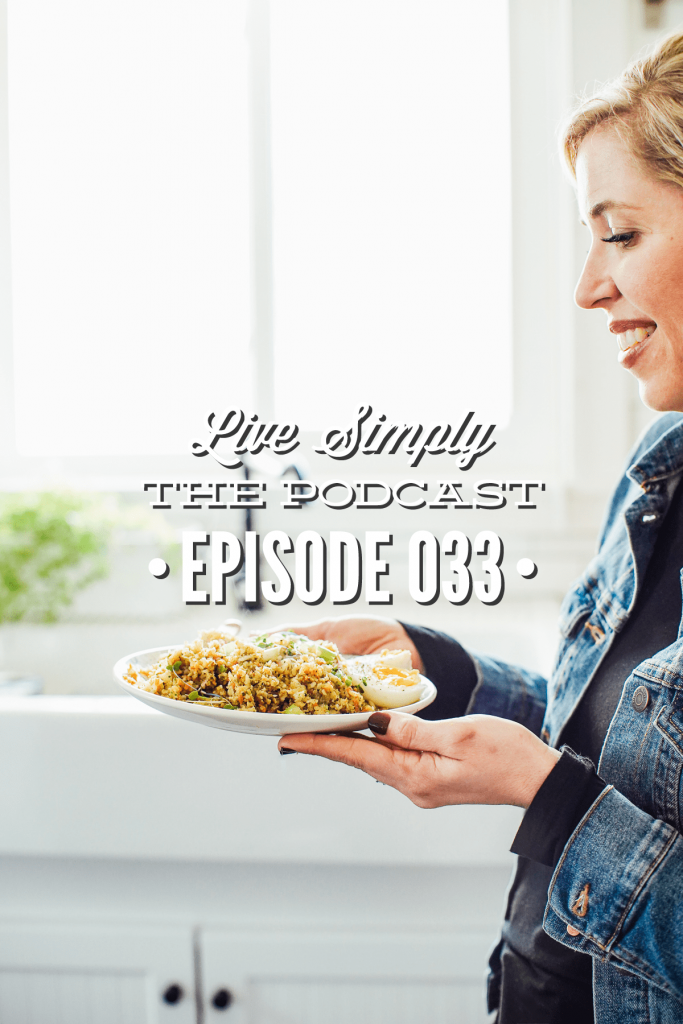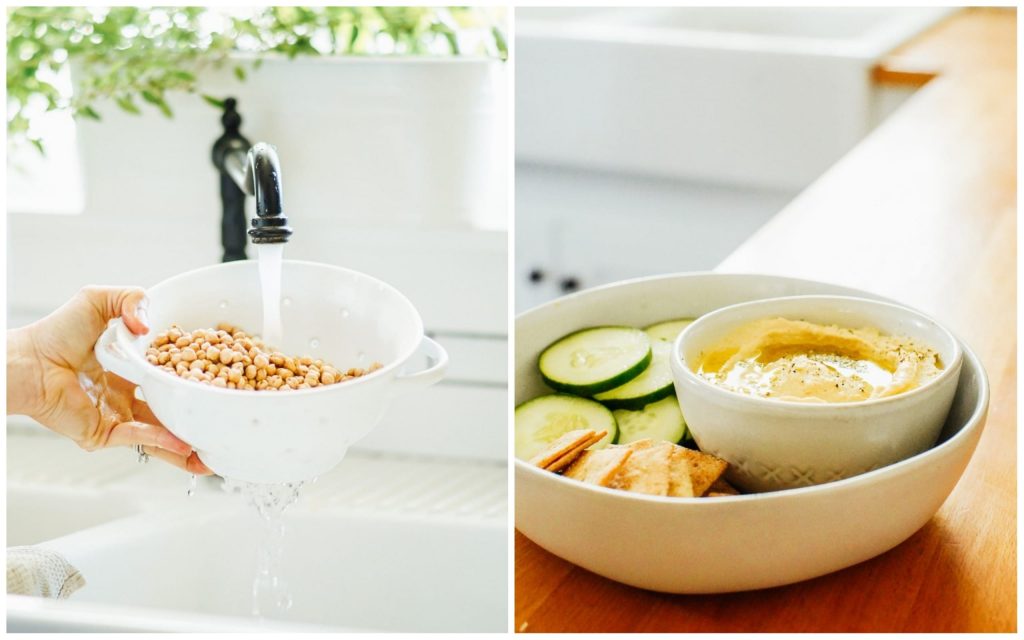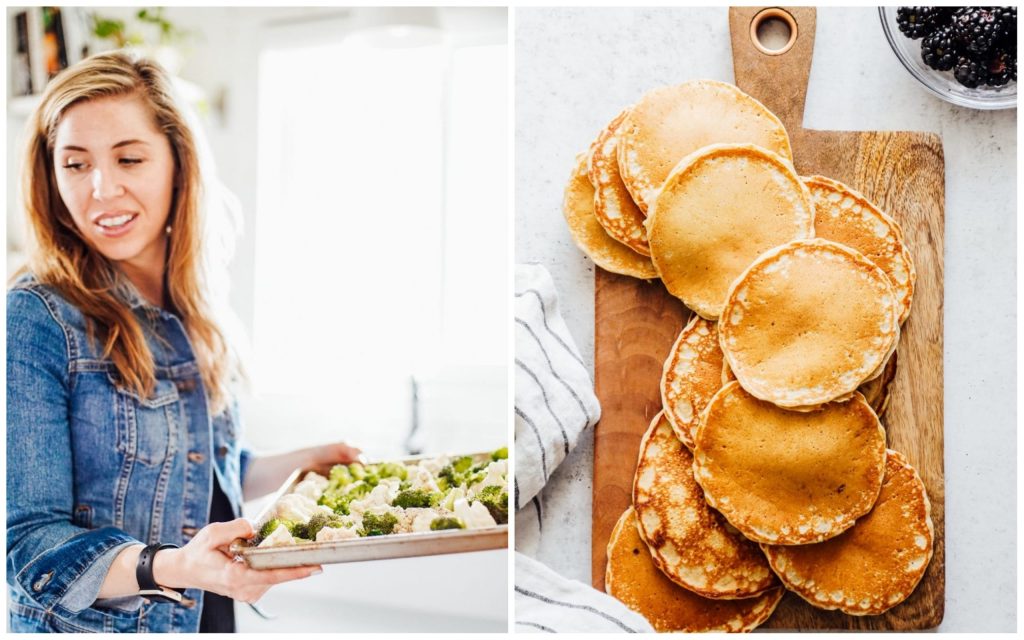In today’s podcast episode, I’m sharing 16 practical ways to stretch your food budget without clipping coupons or sacrificing quality.

Want to Save This Article?
Enter your email & I’ll send it straight to your inbox. And you’ll get new recipes & tips each week.
Listen To The Podcast
Listen On iTunesListen On Stitcher Listen On Spotify
Show Notes
Resources Mentioned In Today's Episode- Episode 013: Meal Planning Podcast
- Instant Pot Dried Beans
- Homemade Biscuits
- Homemade Vinaigrette
- Organizing Pantry
- Organizing Fridge
- How to Cook a Whole Chicken: Instant Pot, Oven, Slow-Cooker
- How to Make Chicken Broth in the Instant Pot
When it comes to eating real food, one of the biggest objections I hear is, “But it’s just too expensive!” I think real food can definitely come across as expensive.
I truly believe a real food lifestyle can be affordable! Today, I’ve compiled a list of 16 budget-friendly lessons from my own real food journey. I think you’ll find most of these lessons are incredibly practical.
Food budgets can vary quite a bit, depending on your financial resources, the area you live in, your family size, or whether you grow some of your food or raise some of your own food. No matter what your food budget may be, these lessons apply to everyone.
Before I share these lessons, one thing to note is real food can be costly. I don’t want to discredit this fact. And while there are ways to stretch your food and make it affordable, sometimes purchasing the initial food comes with a heftier price tag. For example: Pastured eggs and meat from a local farm is pricey in our area. I often hear people at the market remark when passing by the farm booths, “Oh, that meat is so expensive! I’m going to stop by Publix and get chicken because it’s so much cheaper. I can’t believe they charge that.”
Our processed and industrial system causes us to think that food should be cheap (and fast, for that matter). I believe this system has created a false sense of the true cost of raising and growing our food. What people don’t see is the farmer at that booth isn’t trying to scam them or hike prices so high that it makes food seem elite. Rather, what they’re seeing is the true cost of chicken raised in a way that’s not mass produced or subsidized by the government.
When we talk about food and the cost of food and budgets, we have to think about priorities as well. Many times it’s easy to complain about food prices, but then drop money on entertainment, cable, expensive new cell phones and gadgets. For us, we’ve decided to spend more on food and less on entertainment. We’ve also made the choice to live in home that’s smaller and not overly fancy or decorated with expensive items. We live under budget in this area so we can make room in our budget for other priorities.
Michael Pollan sums this up best in his book, In Defense of Food, “While it is true that many people simply can’t afford to pay more for food, either in money or time or both, many of us can. After all, just in the last decade of two, we’ve somehow found the time in the day to spend several hours on the internet and the money in the budget not only to pay for broadband service, but to cover a second phone bill and a new monthly bill for television, formerly free. For the majority of Americans, spending more for better food is less a matter of ability than priority. We spend a smaller percentage of income on food than any other industrialized society; surely if we decided that the quality of our food matter; we could afford to spend a few more dollars on it a week–and eat a little less of it.”
That said, I know it’s possible to enjoy real food on any budget. No matter what your budget may be, we should be smart, intentional, and strategic about what we buy, how we use our food and how we can stretch our food–which in the long-term saves money and allows us to be good stewards with money and also the food we consume. Let’s talk about 16 ways we can do exactly that.
- Buy seasonal produce: It’s hard to break away from favorite fruits and vegetables, but focusing on seasonal produce can save hundreds of dollars each year. For example: Fall time is typically considered apple season and a great time to stock up on low-priced apples. During the summer, apples can cost $7-9/bag (ouch!). During the summer is when berries abound, so instead of purchasing apples, go with the berries. Seasons vary across the country, so the best way to get to know the seasons in your area is to visit a farmers’ market, or just watch the sales in the grocery store.
- Meal plan like a pro: Without a meal plan, food can easily rot in the back of the fridge or sit unused in the pantry. A meal plan is a practical guide for what to buy and how to use that food. You can learn more about how I plan in episode 13. As I share in that episode, meal planning doesn’t need to be complicated or time-consuming. I recommend coming up with a list of meals you can regularly rotate, which will help you build a meal plan in just minutes every single week.
- Reuse ingredients strategically: Meal planning also allows you to strategically reuse ingredients which means less waste. Instead of purchasing one ingredient for a one-time use (and there’s nothing wrong with doing this, sometimes you need to), think of ways you can purchase an ingredient and use it multiple times throughout the week. Not only will this save you money, it will also save you from throwing out a ton of food at the end of the week. Which again, also saves you money! For example: If you purchase a gorgeous head of Swiss chard for a quiche recipe, plan to use the remaining greens in a simple green veggie sauté and green smoothies. If you purchase beets, roast them ahead of time and use one to make beet hummus, a couple in smoothies throughout the week, and the remaining beets in a salad. If you cook a whole chicken, use the bones to make broth and then turn that broth into a soup. And use the leftover chicken meat as a protein in salad, make chicken salad for a lunch, or use the remaining chicken in a soup.
- Eggs are powerful: Pastured eggs can be expensive ($4-7 dozen); however, eggs are a great source of fat and protein. And 12 eggs can really stretch far. Good protein and fat means you’ll feel full after a meal (full= less food/snacking). Eggs can be used in multiple budget-friendly recipes: frittatas (with meat or veggies), egg burritos, topped on a salad, scrambled eggs, baking, fried rice, omelettes, and just served as hard or soft cooked eggs. As far as a protein goes, eggs are a great deal when you consider how far they can stretch and how many ways you can use them. If you can’t find pastured eggs, or they’re too expensive, go with the best option you can find. We’re not after some perfection here.
- Stock dry beans: Repeat after me, “Dry beans are my friend.” Dry beans are filling, super cheap, and can be used in a variety of ways. I use beans to make: soups, tacos, hummus, dips, quesadillas, salads, bowl style meals, a snack–like roasted chickpeas.
- Cut meat in half with cooked beans: To reduce food costs, I sometimes substitute half the meat called for in a recipe with cooked beans or sometimes mushrooms. This works well with tacos and soups/stews. You can also do this with shepherd’s pie. Instead of using a full lb of ground beef, try using lentils or mushrooms. Beans are incredibly filling and add bulk to a meal.
- Name your priorities when it comes to organic: Purchasing 100% organic produce simply isn’t possible with my budget and location. Naming my priorities is important. My priorities are grass-fed dairy (or the highest quality dairy I can find), grass-fed/pastured meats, einkorn and quality bread (because it agrees with me) and pastured eggs. That’s where the largest chunk of our grocery bill goes. After that, I’ll shop for organic fruits and veggies based on the dirty dozen list–during the season some of my produce usually comes shop at our farmers’ market and my CSA. And of course, shopping in season brings down my cost for produce significantly. My priority isn’t all organic produce. I regularly purchased conventional produce from a produce stand or the grocery store, using the dirty dozen list as a guide, so I have the money to spend on my high priority stuff.
- Cook from scratch: Cooking from scratch is much cheaper than purchasing ready-made food. For example: Ready-made “organic” biscuits from the health food store cost $4.99 for a single tube. Homemade biscuits cost: $3.99 for a bag of flour, $2.99 for a bag of baking powder, $9 for a gallon raw milk, and $2.00 for a stick of butter.
Wait, Kristin, homemade is more expensive! It would appear that way, but remember, the store-bought product only makes twelve biscuits. The “from scratch” ingredient list will make dozens of biscuits and other recipes. Another example of this is salad dressing. It takes just a few minutes to whisk together a homemade salad dressing (I’ll link a good one from the blog), which costs just a fraction of a store-bought dressing when you factor in the multi-purpose ingredients used to make that homemade dressing. - Eat fat: Fat is your friend! I know, it’s hard to forget everything the ’80s and ’90s taught us about “good nutrition.” Thankfully, fat is once again a friend and has always been our friend. Fat and protein help fight food cravings so your belly feels full during the day. In fact, when you’re eating naturally-occurring fats in your diet, you generally don’t need to snack all day or constantly be opening the pantry or fridge. The thing is, processed food is full of empty calories. Real food is full of fats and calories that sustain us and fill us up. It’s full of nutrition that our bodies need. And fat is part of this nutrition–it’s incredibly satisfying and will help you feel full and satisfied, which means you don’t have to consume as much food.
- Buy in bulk: Purchasing ingredients you use regularly in small quantities can add up. For example: A small honey bear from the health food store shelf costs $7.99. Purchasing local honey in bulk (1 gallon jug) costs $45. And honey lasts forever. Items that can be purchased in advance: dry beans and rice (from the health food store bulk bins), honey (local farm), olive oil, nuts and seeds, salt, beef and pork (local farm), oats. The bulk bins in stores are a great way to do this, because you can purchase as much as desired and you’re not paying for extra packaging. Costco is another great way to stock up on nuts and seeds and other pantry foods like olive oil and tuna.
- Keep your food visible and organized: It’s easy to purchase items you don’t need because you simply can’t see that item in your pantry. Keep ythe food in your pantry organized and visible. Don’t stuff food in corners and out of sight. This will keep you from overspending on items you already have or that spice you actually have but thought you needed. And when it comes to the fridge, always clean out your fridge at the end of the week, or before creating your meal plan or shopping for food. Not only will this keep you from over-purchasing food you already have, but will also help you create a plan for how to use the ingredients you already have stocked in your kitchen. I’ll put a link in the show notes for a post I wrote about organizing your pantry and one for organizing your fridge. In those posts, I share exactly how I organize my food, my favorite storage containers, and more.
- Shop your inventory: When you sit down to meal plan take a look at what you have in your pantry, fridge, and freezer and plan as many meals from your own food stock before a list of items you need to buy.
- Embrace whole cuts of meat, particularly when it comes to chicken: Meat in its whole form, like a whole chicken, is usually cheaper than speciality boneless cuts. For example: 2-3 chicken breasts cost $9-12 and 1 whole chicken costs $20. The chicken breasts will make one meal for 2-4 people. The whole chicken will feed my entire family, and leftovers will be enjoyed the next day and sometimes for two days after that meal. Plus, you can use the bones from the whole chicken to make 10-12 cups of broth! Which will be used to make nourishing soup. Whole cuts of meat, or cuts with bones, are generally cheaper than boneless cuts of meat. I still use chicken breasts, but I do so sparingly, because I know when it comes to stretching my dollard, it’s better to use thighs or a a whole chicken
- Make your own broth: Most store-bought broths are expensive and the cheap ones usually contain a number of questionable ingredients, or are made from the bones of conventionally raised chicken. Making homemade broth is super easy when you purchase a whole chicken and doesn’t take much time to do. I use my Instant Pot to make chicken broth. I store the broth in the freezer and defrost as needed.
- Grow your own food: Growing your own food can be as simple as a pot of fresh herbs next to your front door. Even homegrown herbs may help decrease food costs. Plus, growing your food can be therapeutic and a from of self-care. You can learn more about growing your own food in episodes 23 and 24. Lacey from the Rab Farm shares everything you need to know to get started growing your own food, whether that’s a pot of herbs or a full backyard garden.
- Shop around: Finally, my last tip is to shop around and get to know where you’ll find the best prices on staple foods. For example, I purchase einkorn flour for baking. I’ve compared prices at several stores and know that the best price ($5.99) comes from a local health food store in our area. I’m not in that area frequently, so when I’m around that area I make sure to stop in and stock up on flour. Comparing prices and shopping around like this saves me $2 per bag of flour and that adds up! The same with nuts and seeds. I’ve found that Trader Joe’s, which is about a 30 minute drive south for me, sells the best priced nuts and seeds in our area. So when we happen to be in that area, I always stop by and stock up. Compare prices on foods you regularly purchase, like pantry items, at local stores in your store and online shops like Vitacost and Amazon.
That’s a long list! I hope this list has given you some ideas for how you can strategically use your dollars to make real food possible, no matter what your budget may be. If today’s episode was helpful, I would love for you to share it with a friend. You can take a screenshot with your phone and share on Instagram or Facebook, or send today’s episode directly to a friend via text.


